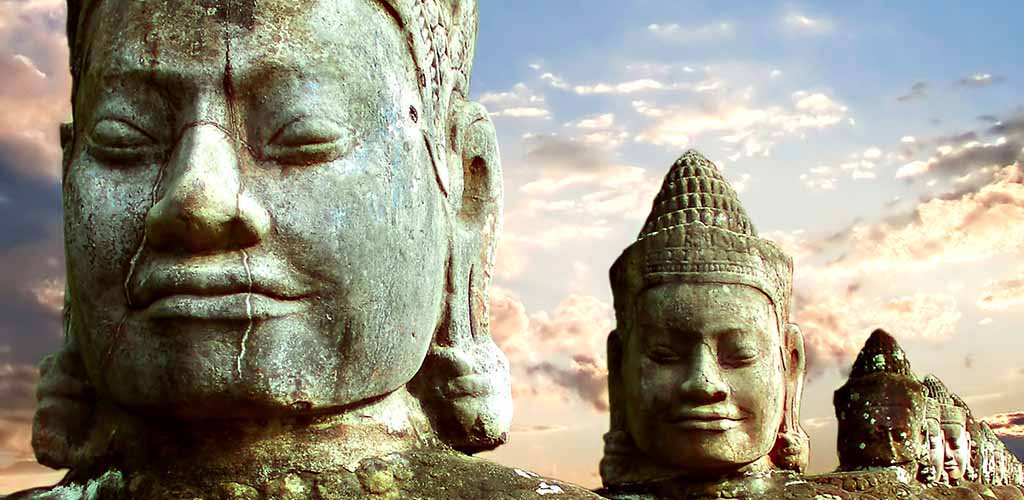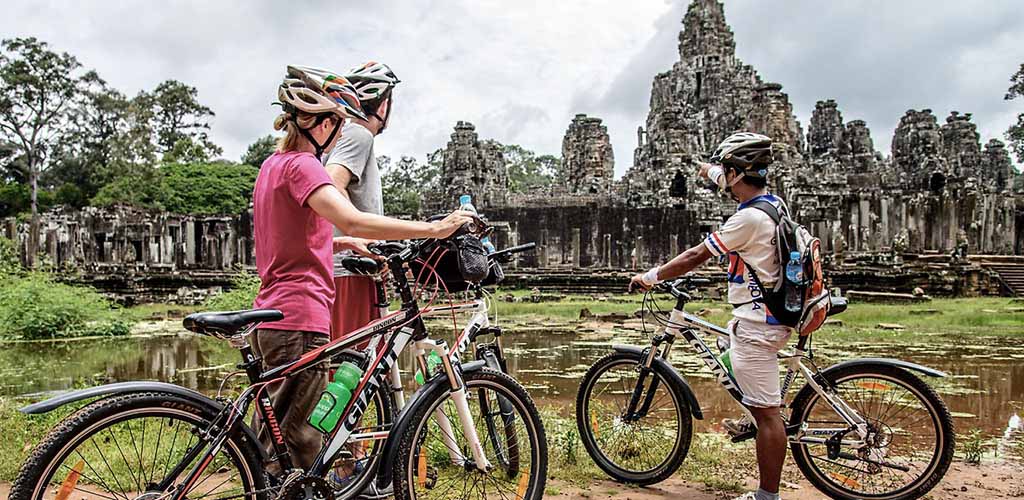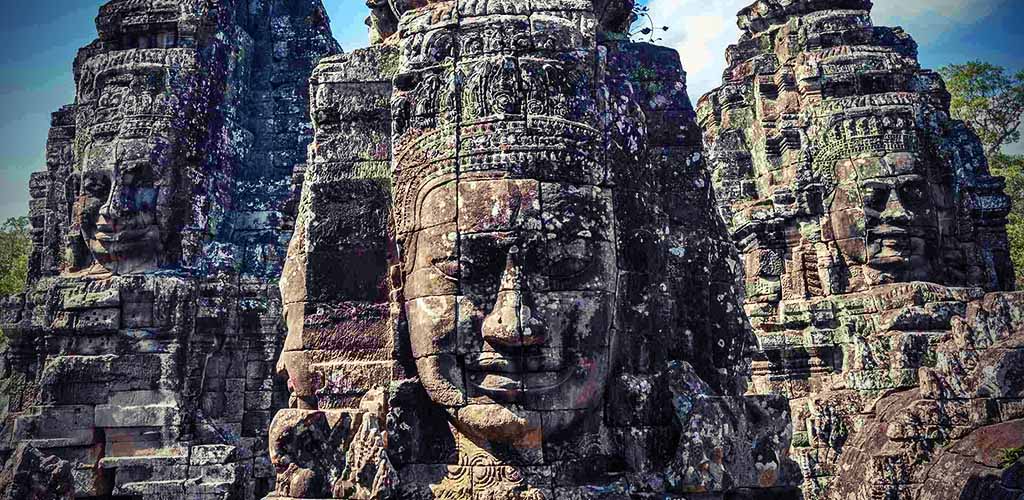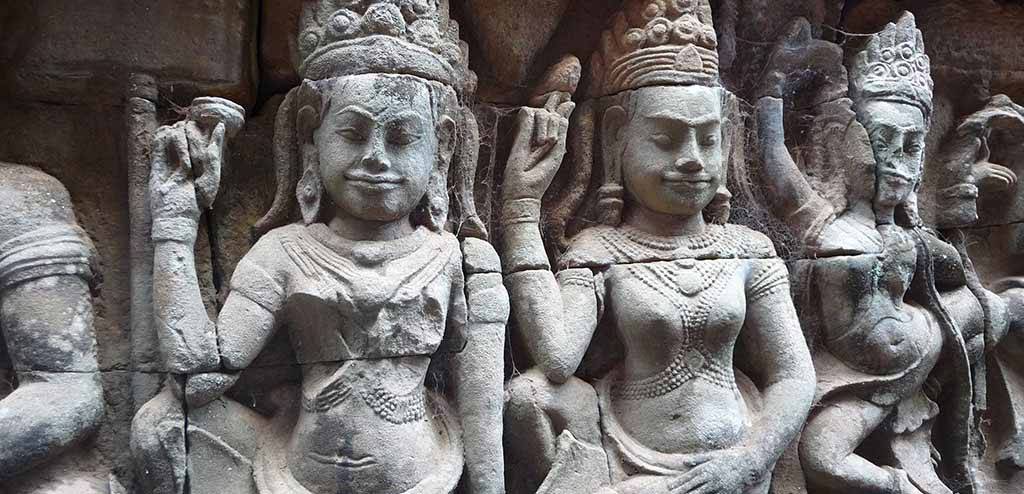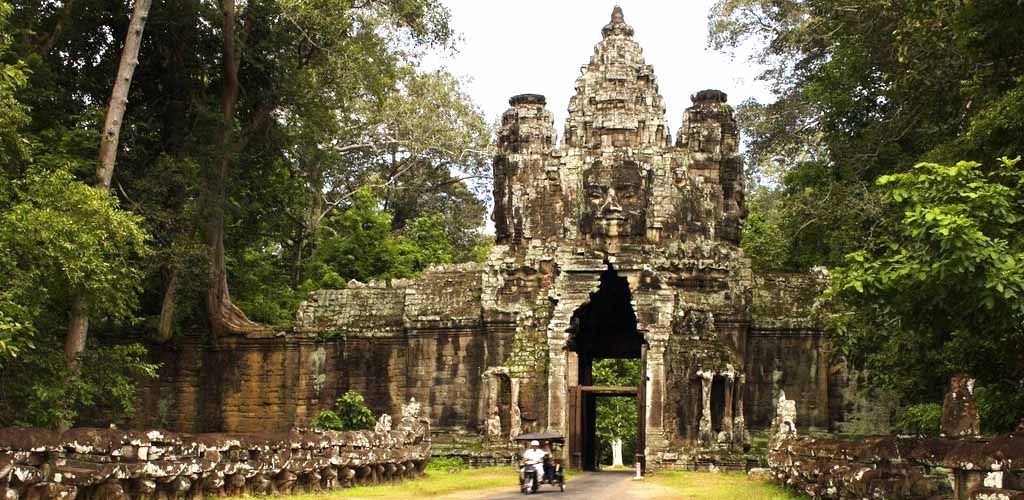Beyond Angkor Wat: Angkor Thom
Splendors of Angkor Thom
B E Y O N D A N G K O R W A T
You've heard a lot about Angkor Wat, but what of its close neighbor, Angkor Thom? And the incredible stone structure of the Bayon? French archaeologist Henri Marchal says to visit the Bayon is to visit a "temple in another world, built by an alien people, whose conceptions are entirely unfamiliar."
At the heart of Angkor Thom is the Bayon, the mesmerizing, if not mind-bending temple of Jayavarman VII's ego whose massive 216 stone portraits smile down at you.
Angkor Thom is a
ruined citadel several kilometers north of Angkor Wat. Angkor Thom encloses
a rectangular area of nine square kilometers, and at its peak may have
held a population of over 100,000, living in tiled or thatched houses.
The building of the citadel dates to around the year 1200. Angkor Thom
enclosed the Royal Palace (now vanished) and a handful of major temples;
the complex was bounded by walls and a moat (now mostly dry) and pierced
by five gates. The city was surrounded with rice fields, which provided
food; these were irrigated with reservoirs, which also supplied drinking
water.
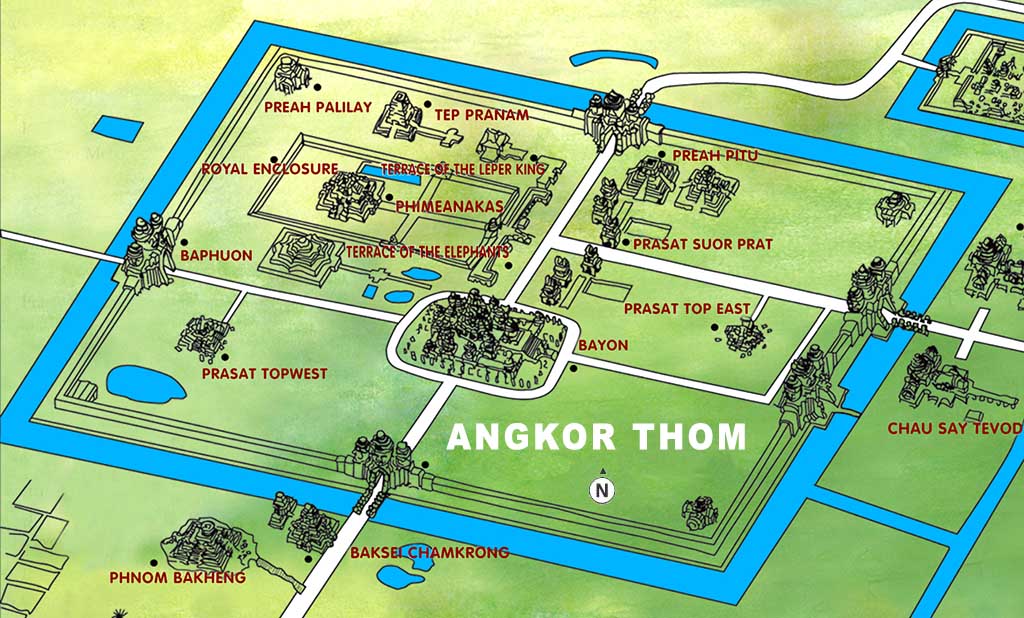
While Angkor Wat is Hindu in inspiration, Angkor Thom resonates with sculpted images expressing the Mahayana Buddhist ideal of Lokesvara (compassion), Prajnaparamita (wisdom), and the Buddha (enlightenment). Although still incorporating Hindu elements, Angkor Thom is a three-dimensional representation of Buddhist cosmology. Temple ground plans reveal a mandala-like base, with radiating symmetrical forms. At the exact center of Angkor Thom lies the Bayon.
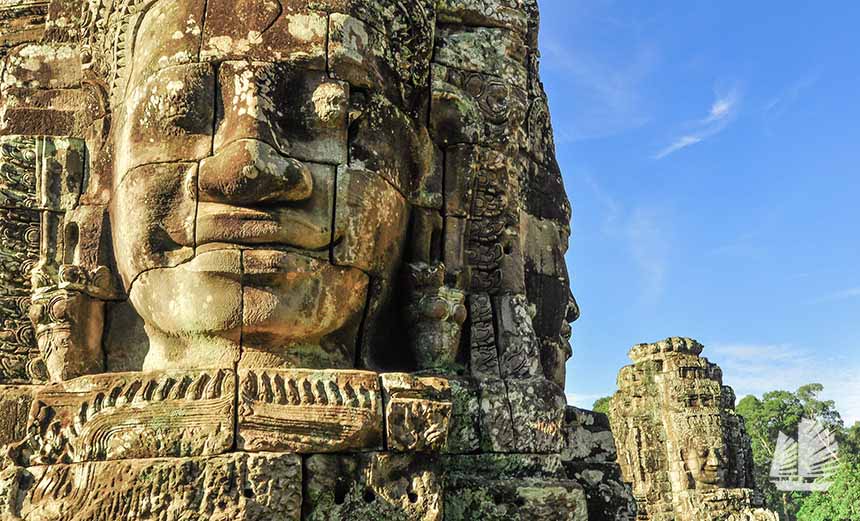
The Bayon: Cosmic Architecture
If Angkor Wat is classic and grand, the Bayon is wild and erratic. Who could've conjured this fantastic structure, and then--even more incredible -- fashioned it from stone? Like Stonehenge or the Pyramids, the bizarre Bayon baffles with its design, its mysterious structure, its aura. The structure is simply amazing. What at first appears to be a random pile of masonry actually consists of massive stones shaped into fluid sculptures, without apparent use of cement or mortar.
The Bayon was once even more elaborate, the central tower apparently covered in gold leaf. Zhou Daguan described it in the 13th century: "At the center of the Kingdom rises a Golden Tower flanked by more than twenty lesser towers and several hundred stone chambers. On the eastern side is a golden bridge guarded by two lions of gold, one on each side, with eight golden Buddhas spaced along the stone chambers." Oddly enough, Zhou Daguan failed to mention the massive heads on the Bayon towers.
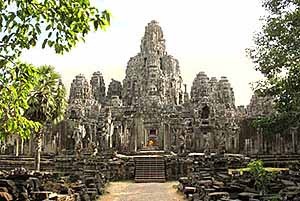 On the top terrace of the Bayon, you come face-to-face with myriad of these giant stone heads topped with lotus crowns. There are dozens of them, originally 54 towers with four heads each of which 37 towers remain. The enormous heads, ranging in size from ten to fifteen feet, features eyes downcast under lowered lids. The faces flicker the famous "Smile of Angkor"—a Sphinx-like expression that seems to communicate much.
On the top terrace of the Bayon, you come face-to-face with myriad of these giant stone heads topped with lotus crowns. There are dozens of them, originally 54 towers with four heads each of which 37 towers remain. The enormous heads, ranging in size from ten to fifteen feet, features eyes downcast under lowered lids. The faces flicker the famous "Smile of Angkor"—a Sphinx-like expression that seems to communicate much.
The importance of the Bayon was not realized until early this century, when French archaeologists cleared 10 square km of land at Angkor Thom. This made it possible to sketch accurate maps for the first time, and it was discovered that the Bayon lay at the exact center of Angkor Thom. French archaeologists surmised the Bayon was built over the foundations of an earlier structure, resulting in dark galleries, deep courtyards, and towers crowded next to one another. Some parts were walled over, the original sculptures left intact within. Hidden below the upper terrace, Henri Parmentier in 1924 discovered a fine pediment of Lokesvara, the bodhisattva of compassion. This indicated the Bayon was Buddhist, and not, as previously thought, Hindu. The discovery of a large Buddha statue within the central sanctuary of the Bayon confirmed this.
Disorder in the construction of the Bayon is reflected in the numerous architectural changes. It seems that after the Cham sacked Angkor in 1177, Jayavarman VII decided the Hindu deities had failed, so he switched allegiance to Mahayana Buddhism. However, he made no attempt to alter existing Hindu elements. The Bayon was caught in the middle -- the foundations are Hindu, but the superstructure is Buddhist. It is estimated that the Bayon took 20 years to build. Jayavarman VII's son and grandson reverted the use of the temple to Hindu (Shivaist) worship, with Brahmans from India gaining great influence over the Angkor court. Heads and faces on statues were destroyed and replaced with Hindu gods.
A Japanese government team working on restoration at the Bayon estimates that more than 200,000 blocks of stone were used for the building. Some of the larger blocks weigh over six hundred pounds. and must be moved by crane in the Japanese project. For the original construction, it would have been possible for four men to carry a piece like this with a sling, but that would not explain how such blocks reached the heights of the central tower. Reassembling pieces left behind by French archeologists is proving a giant jigsaw puzzle for the Japanese--it took the Japanese group four years just to restore a small library building at the Bayon (restoration can only proceed six months of the year because of the rainy season).
The ancient Khmer way of life is written in stone: captured in stunning bas-reliefs on the outer and inner walls of the Bayon. Running the length of the outer and inner gallery-walls, these bas-reliefs depict historical events and mythical stories, and offer rare glimpses into daily life at Angkor Thom. Many of the bas-reliefs are in bad shape, but enough remain to give us insights. Panels show the Khmer battling their enemy, the Cham (from what is today Vietnam): on land, elephants are deployed like tanks; in the water, on Lake Tonle Sap, corpses are thrown to the crocodiles. Other vignettes portray a fisherman casting his net, a man climbing a coconut tree, cock-fighting, scenes of temple construction, princesses partying with their suitors, and even performers from a Khmer circus—jugglers and wrestlers.
View Angkor Trip ideas
